THE JOURNEY:
Post finishing our short exploration of Satpuda on a boat ride and mega opening of the tour courtesy sighting of huge crocodiles in Denwa backwaters, we had our agenda cut out. Mend the lesser damaged wheel of our car so that one can act as a stepney and after exploring a few shops which were ready to exploit our situation by demanding exorbitant money, our Karma landed us in a right place, this smiling gentleman tactfully not only mended our alloy wheel economically but also gave us important inputs on how to ride in such situations with a makeshift namesake stepney. Once our worries of tyres were over we had our empty tummies to answer to we had delightful dal and parathas to satiate our bellies at “Nanhe Maharaj”.
With our bellies full and car if not in best but at least in good shape we left for our next destination, the legend of Kanha was waiting for us.
Since my childhood I always had fascination about Jungles of Kanha Kisli, credit for this fascination goes to it unique name but much of it goes to a chapter dedicated in my supplementary reader book which we had in our syllabus in class 5th. I use to keep staring at the photograph of a barasingha in meadows.
While passing through small villages around Pipariya we came across a lot of sights which have been wiped away from the memories of us city types, like those of Men on bicycles carrying radio straps, can still be seen, Buses and other public transports are overwhelmed by sheer number of commuters sometimes also carrying the four legged ones likes goats and small cows. People hangout of these vehicles, perched on bonnets of jeeps and even on top of buses. The blaring music from these vehicles can be heard for miles around and follows a typical cycle of devotional music during the dawn and the dusk and music of 90’s with extra Jhankar beats in the noon. The gaily decorated jeeps and tractors are a sight to see.
Soon the rustic and speed breaking traffic of Pipariya and nearby villages gave way to the green paddy fields around. Soon the separate Ghat road which leads to Parasiya started. It was on these Ghats on which I watched a huge tiger from a bus while traveling with my father.
As these Ghats finished, we came across some human settlement and the name of the small road side village was Delakhari and decided to have some tea. This small tea shop was strategically located near a hand pump on highway. While on long drives I have always followed one rule “Eat whenever you get a chance to eat”, following this guiding star of my travel philosophy while other 3 explorers were waiting for their less sugar cup of tea, my eyes caught up with “Balushahi” kept in blue painted wooden framed display counter of tea stall. I went ahead and asked for one piece and to my utter surprise this was perhaps the most delicious and delicately sweetened Balushahi that I have had till now. On my reaction and insistence the gang also followed the tasting ritual which was just the start if procession of saying one more and ended till we had half more piece of it 4 to 5 times.
By the time we crossed the smoke filled town of Parasiya and reached district place of Chindwara it was 6 PM and it was already dark.
We took road to Balaghat which is 190 KMs and 3 hours of drive from Chindwara, out approximation was that latest by 11 or 12 we should reach at Mukki Guest house in Kanha. The best part of this road was one that it was in prime condition and other and more significant aspect was it passed through south western buffer zone of Pench Tiger reserve, while Abhishek on wheel I tried my level best to spot any owl sitting by on a road side perch but could not succeed. Once we reached Balaghat by 10 PM we were sure of reaching Mukki gate in an hour or so as it we had just 69 KMs to travel. We were on schedule.
But this was just the start of our miseries and adventure. As soon as we left Balaghat and sign of civilization finished sights of road construction in full swing welcomed us. It was a work being carried out of massive proportions as we could see entire base of the road getting dismantled and laying of new base was going on.
Looking at these earth shattering scenes we asked a lorry driver at construction site and should we continue with this road or take an alternative road which would have cost us 30 KMs more, he told us that next 2 to 3 KMs is in bad shape and remaining road is drivable. The benevolent driver also flattened a few big boulders with his lorry so that we could drive through. Once we left we saw a huge earth mover digging up a hole on the road which we just passed through. Going back was not an option now. We were committed to this road now.
Although the road was not as bad as what we came through still it was struggling to fit in to any definition of word “ road”, It was like driving on Mars, potholes, big boulders were coming in tandem one after the other sometimes gracious enough to come together. With a makeshift namesake stepney we were ultra-cautious about this drive. The best part about such drive that I like is that rhythm of the road gets you. Such a journey could be painful but a long road journey in any form is a meditation. You have to be there in the moment. You cannot dream of future or regurgitate the past for too longer or you are liable to be “ambulanced”. Your mind is spared of the mundane cares it so badly deserves.
After 3 and a half hour of rhythmic torturous drive we reached our destination Mukki Gate where our stay was arranged at forest guest house.
ABOUT KANHA
ZONE in Kanha: The Kanha National Park area is divided between 2 districts Jabalpur and Mandla. The Kanha National Park is spread across the area of 940 sq km in the Maikal chain of hills. By bringing up the buffer and core zone all together, the Kanha Tiger Reserve has the total area of 1945 sq km. The park has 4 Safari Zone, Mukki, Sarhi, Kanha and Kisli. Amongst the mammals the humble Indian Gaur is the biggest and shy Indian tree shrimp being the smallest in mammals. Kanha and Mukki zones are more famous for so called “tiger sightings”. Most of the people who go inside tiger reserves treat these jungle safaris are tiger safaris and remain ignorant of the fact that the tiger is just one piece of a big jigsaw puzzle that we call nature. And even the smallest and commonest of creatures like ants and termites play as important role in keeping the Eco system of forest up and running. But when I think about this in more detail I realize that even the most seasoned naturalists and “tiger conservationists” deliberately fail to understand this and focus their activities around tiger conservation and not forest conservation as a whole. In my view the only thing that wilderness needs is undisturbed and intervened expanses of land and nothing else and nature will start taking its own course.
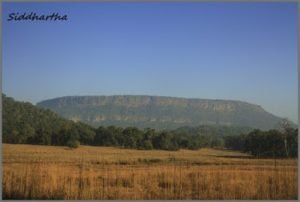
Talking about conservation clouds of copper mining in nearby Malajkhand region always loom large on these forests, several other forests in India face similar threats and challenges.
A sudden discovery of any mineral now a days make mining corporate start shelling out on “corporate social responsibility” related activities in that area. More often than not these areas are the areas in which even government has failed to put up a lamp post or dispensary in over 60 years of independence.
THE TRYST BEGINS
Straight away we checked in to our rooms took a bath and some rest and were ready for our first Safari. All the pains of driving entire night through Martian surface were gone now. As our jeep arrived we got to the door of entry gate and got our designated guide Mr. Ganesh, sleek face, slim body and a smiling face with mustache. As soon as I started asking him about birds in Kanha and told him that primary agenda is birds and not tiger, with a big smile on face he said “majaaaega”, the driver of the jeep told us that Ganesh Bhai is an expert bird watcher. Once formalities were done we were up and roaring to get inside the Jungle.
As we were discussing about flora and fauna of the forest one thing that I observed that the Sal borer epidemic has made significant inroad in to the Jungle. Blots of brown have engulfed the green canopies as the larvae of the insect bore furiously into the massive trunks and suck the sap from inside. This beetle comes out of hibernation in monsoons and drills holes in Sal trunks to lay eggs, the eggs later form in larvae and feed on the sap of the trunk making the tree weak and hollow from the inside and bound to fall. This initial signs of this epidemic got noticed in 1992, but the government juggernaut started moving after 1995 and by then it as too late. The eerie sound of millions of sal borer beetles busy drilling huge trees has broken the tranquility of one of the best ecosystems in central India, the irony is that forest department is still grappling with methods to contain this epidemic that too with minuscule success.
Just a few minutes in to the safari and I was getting my answers to the the question that why Kanha is regarded with such high regards in Indian wilderness. It is a perfect mix of different habitats, high hills, lush meadows mixed with water bodies.

The meadows of the Kanha are what strike you the most, soft golden grasslands, with glades of grass all aligned in one direction ringed by the indigenous emerald Sal forests, and grazed by small herds of pretty spotted deer in some places and a dominant male peacock pecking the ground unperturbed keeping one eye on his harem of ladies, unconcerned about your appearance in their tranquil natural world. In the background, low sun kissed and flat topped hills paint the picturesque background.
One thing I realized that the jungles of central India highlands connected with me in different manner. It’s the connection that you establish with the Jungle that takes you in to trance with nature. These jungles were resonating in a different manner, very different than the Western Ghats in which I have done exploration so often. The forests of Western Ghats have more aromas but less visibility due to the dense nature of Western Ghats. But here in central highlands the aroma gets reduced and gives way to more visibility. Also the roads inside the park very straight, they were so straight in certain patches that it felt like driving in a village apart from the fact that citizens of village here were replaced by jungle folks.
As we approached a meadows area it was already 7:30, sun came out to and fog got reduced. I observed a cheetal fawn standing motionlessly in the waist height grass with no parents around. A thought that came to my mind was how easy and granted us humans take daily aspects of our life like drinking water, eating and sleeping, how these daily aspects of life becomes so tough for wild animals. The sleep is never long enough and invariably gets disturbed by alarm calls by other animals to announce possible presence of predators. Eating is never a family affair or a leisure activity, ears are always on stretched mode to detect slightest motion of any predator emerging from tall grass and charging to puncture the windpipe and snatch away life of self or any one of the clan. Considering all these tension filled and cautious life styles no wonder that the life expectancy (even that of an uninterrupted life) is not even half as that of us humans, and we keep cribbing about stress in our lifestyles.
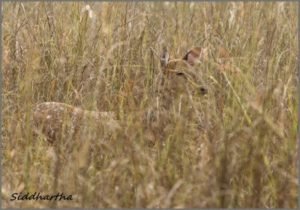
We were looking for the most precious sighting of the Kanha tour the famous “Barasingha” or twelve horned Indian Reindeer. We got obliged by a pair of Sub adult Barasingha, with velvet touch small antlers confirming them being males. Ganesh Bhai told us that we can get a sight once fog comes down and luck smiles on us.
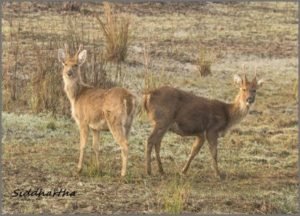
As the fog settled down completely and light became better we started to get a better view of Kanha wilderness, the sounds of jungle started to hit our ear drums were the yowl of a muster of peacocks. The first mention able sighting of the day was a pair of Indian scoops owl, sitting confident of their extraordinary camouflage, it was such an extraordinary sight and camouflage. To an untrained eye they would just appear as a skin of wood remaining on a tree hole. Just on a juxtaposed tree a pair of sub adult Indian roller, who doing sorties from a dried perch looking for a juicy betel breakfast.

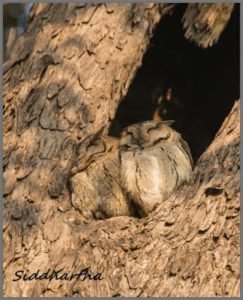
As we moved ahead besides a narrow elevated road there was a water body on both sides of road, on the right side a gaggle of Cotton pygmy geese doing morning swimming rituals closely packed with each other, but on the left side of the water was the real surprise of the trip, a lesser adjutant stork was fishing besides the shallow green waters. The lesser adjutant stork will take the first place in terms of being the weirdest looking bird found in India. With a bald head and an uneven cover of hair like strands make it a complete winner in weirdest looking bird category. Presence of this bird is something which I never thought that I could come across in Kanha, but why would people like me go to wild? The answer is to get surprised.
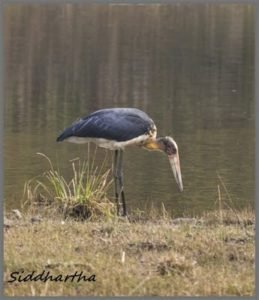
While coming back we approached Babathenga Tank area from other side and was gifted with unique Barasingha behavior, the fully grown Barasingha was entering in to water body and looking for water plants which happens to be its favorite food. It was a sight to behold of and was enough to mark the trip as successful.
Nearby a female Barasingha was eating the grass on the ground, near to it were two cattle egrets and and on top of it was a drongo to pounce on to any beetle or insect which gets out of soil because of churning caused by hoofs of Deer.
The Mukki guest house is a treat in itself for any traveler like me. Old structure with earthen thatched roof, huge rooms and even bigger bathrooms with teak wood furniture indoors and cane furniture in outside sit out makes it a unbeatable place to stay. While having our lunch we enquired about the wilderness of this place and the cook told us that a leopard frequents the back side of guest house to approach a water stream which runs nearby it. Talking about the lunch it was a sumptuous Desi Chicken made with great flavors and was a treat to eat with rice. The rice was cooked in a pot and not in a pressure cooker flavor of rice mixed with this Chicken gravy was delightful.
SECOND SAFARI:
At the start of noon safari we got the information that in the morning a few jeeps have sighted a tiger and a leopard in Babathenga tanks area and Sondar tank area respectively. I was more interested in leopard. In a well wooded patch we heard calls of a Crested Hawk Eagle, but calls were coming from quite a distance and we were unable to locate the majestic raptor. Noon time is when vulture activity is on a high but we got nothing. A black shouldered kite was sitting on distant twig assessing the movement of any possible prey on the ground. Soon the time went by and we reached the Babathenga tank road, this is a huge water tank with meadows surrounding on inner periphery and clusters of tree making the outer periphery. As we waited patiently at Babathenga tank and like at a cue the alarm calls of spotted deer started from the clusters of tree. The Alarm calls changed directions and were coming in tandem. After 15 minutes or so the alarm calls died. We checked the meadows with our binoculars, but nothing came across. May be the tiger just changed its sleeping position. Time went by without much activity further a few tree pie calls came in between the Jungle roads as they chased each other, there was no sign of any raptors as well. I inquired about any record of rare forest owlet in this forest, to which I got an answer in negative.
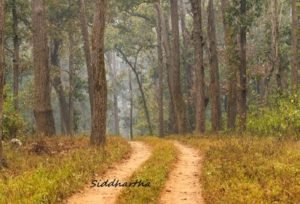
After spending equal amount of time at Babathenga and Sondar tanks we started our journey back to exit gate as the time was getting over. As the evening approached transformation of the landscape was extremely overwhelming when sun was setting down at distant horizon. Long shadows of evening were becoming night and Sal forest of Kanha was turning heaven…. So serene and gorgeous landscape with absolute wilderness.
DAY 2
The night sleep although was supposed to be easy as I drove entire night but all of a sudden the weather became overcast and an already cold air suddenly picked up spike from the drizzle and became chilly to say the least. Rum was the order of the night and we obliged. I woke up twice in the night to check for 2 things, status of rains and any alarms calls from the jungle behind. Sounds disappointed, rain was continuing its sound and there were no alarm calls both the times.
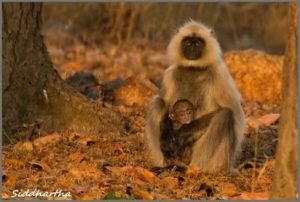
Unseasonable rains, misty mornings and extreme cold were making Kanha National Park a tough destination from a photography perspective this morning. With no expectation of big cat movement I had diverted my attention to landscapes and swamp deers (barasingha). I was particularly interested in (Barasingha) swamp deers as I was yet to get that good perspective of a swamp deer stag in the ever beautiful and scenic Kanha meadows. I focused my energies on a dream silhouette shot of the Barasingha with lumps of grass in his kingly antlers and bugling his mating call with steamy fog coming out of its big nostrils, but the sun light refused to improve in entire trip and we had to get content with listening to calls of Grey hornbills and Crested serpent Eagle.
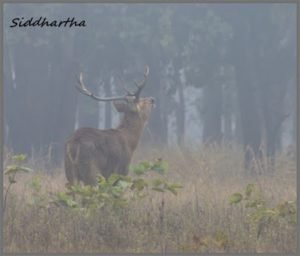

It was like the entire spirit of jungle surrendered to the damp and cold weather. In cricket it was a kind morning in which the team batting first team gets winded up in double score.
With birds activity down to minimum and a few mammals coming across we came to a path where a leopard was sighted last evening and waited with no noise so that we can be graced by this wild beauty, but not to be. A Jungle owlet was watching us do this from a distant tree on a bare perch.
With nothing coming through we moved ahead and came across a mile stone kind of stone on a T Junction, I thought this must be zone separation indicator or must be signifying demarcation of a forest beat office but our Guide told us that this is the grave of Iconic “Lapsi Shikari”, Lapsi was a local tribesman and a master wild tracker and use to give his services to landlords and poor peasants for killing man eaters or assisting landlords in their hunting expeditions. Once in 1930 Lapsi was on a hunting excursion and a man eating tiger came in front of him and his troupe and charged at them, Lapsi Shikari came ahead and dashed at the charging tiger which started a duel between a fully grown man eater and Lapsi. Laspi lost his life but successfully saved the members of hunting party. His heroics of killing animals and bravery now tell his story in one of the protected areas for wildlife, what an irony indeed. The second legend is of Late Ravibhan Singh Thakur, he laid his life trying to save a spotted deer fawn from drowning. Ravibhan was at his beat office when he got to know about a deer fawn getting stuck in a water body and is drowning, Ravi took the dive in water to save the deer and managed to keep the head of deer high but in the process himself got tangled in the waters weeds and could never got himself out and laid his life. I am surprised why there is no wildlife conservation award in the name of this brave heart and this story is worth sharing with every one even at student level. An award in the name of this person can also be initiated for young Turks doing exemplary work in field of conservation. The second story was good enough to lift our spirits, nobody in Gypsy spoke for a while. Such legends make the legend of of Kanha more legendary.

We were scheduled to take the 2nd Safari of the day as well but with unrelenting weather we decided to bid adieu to Kanha and move to out next destination Bandhavgad..
The Kanha proved out to be a brilliant destination, undisturbed grasslands, holding on the very rare set of hard ground swamp deer’s of India and their revival is a one of the success stories of wildlife conservation in India. Kanha meadows holds so much promise that I have made a promise to come back again and come back for more…
Adios Kanha

